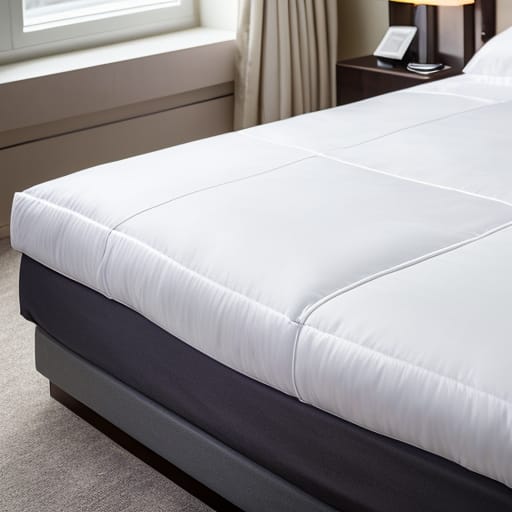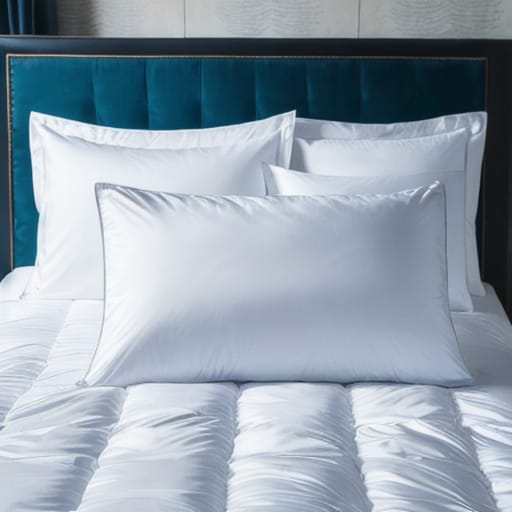When it comes to bedding, down duvets stand out for their legendary softness and lightweight warmth. But with their higher price tags compared to options like down-alternative comforters, are luxury down duvets really worth it?
This beginner’s guide will walk you through everything you need to know about **down duvets – **from fill power and construction to care and cost considerations – to help you decide if a down-filled duvet is a smart long-term investment for your bed.
What Exactly Are Down Duvets?
Before weighing the pros and cons, let’s start with the basics – what are down duvets?
Down duvets, sometimes called down comforters, are filled with the fluffy under plumage from ducks or geese. This super soft duvet filling provides lightweight insulation that makes down duvets ideal for keeping warm on cold nights.
True down bedding consists of at least 75% down cluster plumage, with small bits of feather mixed in. The down clusters interlock to trap body heat, while still allowing good breathability so you don’t get too hot while sleeping.
This means down duvets provide the holy grail combo of insulation, breathability, comfort and durability.
But does that make them worth the splurge compared to cheaper alternatives? Keep reading to see the key benefits of down duvets and why they may be worth investing in.
The Fill Power of Down
One of the specifications to understand when comparing down duvets is fill power.
Fill power measures the loft or fluffiness of the downfilling inside the duvet. It ranges from about 300-900. Here’s how it works:
- Higher fill power means larger down clusters that trap more air. This increases insulation and warmth.
- Lower fill power has smaller, more compact down clusters and feathers. The duvets don’t have as much trapped air.
For example, an 800-fill power-down duvet will provide more insulation than a 600-fill power-down duvet. It will trap more air thanks to bigger down pockets.
Most experts recommend down duvets with fill powers over 600. This balances durability with superior coziness and heat retention. Popular fills are:
- 700-800 fill – Very warm and still breathable. Provides sinking comfort without overheating.
- 600-650 fill – Well-balanced warmth at an affordable price point for many.
- Above 800 fill – Ultra lightweight with maximum loft and warmth. Premium level luxury and heat.
So while high fill power down costs more, it typically means a warmer, fluffier, and longer-lasting duvet.
Shell Materials and Construction
Along with fill ratings, the shell fabric and construction of a down duvet also impact quality:
Baffle Boxes
Baffle box construction has small fabric boxes sewn into the duvet to keep the down evenly distributed inside. This prevents cold spots or shifting.
Baffle boxes are usually found in higher-end down duvets and maximize insulation. But they also make the duvets harder to wash compared to the next option…
Sewn-Through Boxes
The more affordable construction alternative is a sewn-through design. Here the duvet sections are simply sewn together, allowing fill to move between compartments.
While thickness varies more than baffle box duvets, the simple construction makes these duvets easier to launder. And they still provide good warmth for the cost.
Outer Shell Fabric
The outer fabric holding in the delicate down must balance breathability and durability. Thread count impacts both:
- Lower thread counts (200-400) have a softer hand feel many love. But they can compromise long-term durability after multiple washes.
- Higher cotton thread counts (600+) use tighter weaves that are stronger and longer-lasting. But they have a crisper texture that some dislike.
Look for strong, breathable shell fabrics with a reasonable thread count based on your priorities of softness vs durability.
Comparing the Cost: Is Down Worth It?
Now for the big question: with down duvet prices ranging from $100 to over $1000 – are luxury down-filled duvets worth the investment compared to cheaper synthetic alternatives?
Here are the main factors to weigh:
Upfront Cost
- There’s no denying natural down duvets cost considerably more than polyester options when buying new bedding. You’ll spend $250-500 for quality down, compared to $100-200 for alternative down.
Long-Term Value
- Unlike cheaper comforters that flatten within a couple years, well-constructed down duvets can retain their loft and insulating value for over 10+ years when properly cared for. The superior durability balances out the initial price difference over time.
When weighing long term use against replacement costs, quality down duvets often provide better overall value.
All-Weather Insulation
- Goose down and duck down provide peerless insulation, keeping you cozier on frigid winter nights compared to alternative down. Even lightweight summer-weight down breathes better and insulates better than cheaper polyester too.
Ultimate Comfort
- With cloud-like softness and cushioning support, pure down cradles the body better than any synthetic alternative. If sleeping comfort is a priority, down helps you sleep deeper.
Down vs. Down-Alternative: Key Differences
How exactly do down and down-alternative duvets differ? Here’s an overview:
While down-alt duvets offer affordability, down fills provide unbeatable comfort and durability.
The bottom line? If you can afford a bit more upfront, investing in the right high-fill power down duvet for your climate typically gives better long-term satisfaction.

Caring for Your Investment: Cleaning and Storage
Caring properly for a prized down duvet ensures it remains fluffy and insulating for over a decade. Here are some top tips:
Regular Cleaning
- Only dry clean down duvets every 2-3 years maximum to preserve down oils and loft. In between yearly cleanings, air out the duvet and use a duvet cover for protection.
Washing Methods
- When it’s finally time to clean, use a front-loading washing machine (no agitator) on delicate cycle. Add a couple tennis balls to help fluff the down during washing. Air dry thoroughly.
- Between washes, fluff down duvets regularly by massaging the down through the fabric. This maintains even fill distribution.
Proper Storage
- When putting duvets away long term, store flat in breathable cotton bags. Avoid compression which can damage delicate down clusters.
Follow these tips diligently and your down duvet should retain its divine comfort for over a decade – making the investment very worthwhile.
Finding the Right Duvet for You
Ready to start shopping? With all the details above highlighting what makes an exceptional down duvet, focus on these key specs tailored to your needs:
1. Climate-Appropriate Warmth
Choose fill power suitable for your sleeping climate:
- Warm climates: 300-500 fill lighter-weight down
- Year-round temperate locations: 600-650 fill
- Cold winter regions: 700-900+ fill ultra-warm down
2. Preferred Weight
Select lighter vs. heavier density based on your size and sleep style. Different weights suit:
- Children, petite adults, warm sleepers – Lightweight down
- Average adults, side sleepers – Medium density down
- Plus size, cold sleepers, winter use – Extra warmth heavy down
3. Right Size
Pick options sized to drape neatly over your mattress with room to tuck underneath all sides.
Top-Rated Duvets Worth the Cost
Ready to shop for a dreamy down-filled duvet built to last? Here are five of 2023’s top-rated options across price ranges:
1. Royal Hotel’s Premium Goose Down Duvet
- Price: $$$
- Fill Power: 700
- Sizes: Twin to California King
With baffle boxes and 100% cotton cambric shell, Royal Hotel’s offerings expertly balance exceptional insulation (year-round weight) with breathability and resilience.
The high-end Egyptian cotton shell provides satisfying heft that sleeps cool enough for warm spring and summer nights too. Backed by a 5-year warranty – given proper care the duvet should last over 15 years even with regular use.
2. Buffy Cloud Comforter
- Price: $$
- Fill Power: Not specified, approx. 600
- Sizes: Twin/Twin XL to King
For a mid-range option offering serious comfort at a reasonable price, Buffy’s cloud down-alternative duvet mimics many benefits of down at a more affordable cost.
Made from super-soft eucalyptus fibers, the breathable, fluffy fill avoids overheating issues common with cheaper polyester-filled duvets. Plus, Buffy offsets the environmental impact through tree planting partnerships.
3. Luxor Linens Lightweight Down Comforter
- Price: $
- Fill Power: 550
- Sizes: Twin to California King
Luxor Linens 550 fill power comforter keeps costs down with sewn-through construction while providing enough fill for warmth even in cold winter temperatures.
The mid-weight cotton shell balances crisp durability with breathability to prevent sweating. For the price, it impressively rivals the insulation, softness, and resilience of comforters double the cost.

The Takeaway: Comfort That Lasts
While no bedding option can match the cloud-like softness and peerless insulation of high-end goose or duck down-filled duvets, cheaper down-alternative bedding has its benefits too.
Carefully compare the benefits that matter most to your sleep comfort – cost, warmth, longevity, ethical manufacturing – and choose the best option for your budget and priorities. With options now scaling from budget to luxury levels, even allergy sufferers can enjoy the enveloping comfort great down bedding provides.
If top-tier comfort, support and durability top your list, then yes – investing in a quality down-filled duvet delivers remarkable value over years of restful sleep. But more affordable down-alternative duvets offer environmental and ethical advantages worth factoring in as well.
Frequently Asked Questions
Still deciding if a down duvet is right for your bedroom? Here are answers to some common questions:
What’s the difference between a duvet and comforter?
There is little functional difference between a down-filled duvet vs comforter. “Duvet” tends to be used more often commercially, while everyday language refers to them interchangeably. Both consist of the same materials – a fluffy down or down-alternative fill inside a fabric shell.
How Often Should You Replace a Down Duvet?
With proper care like gentle washing cycles and proper storage, quality down duvets should retain their loft and insulation for over 10 years of consistent use before needing replacement. Lower-end down or down-alternative duvets may startflatten sooner, around 5 years.
Is a Higher Fill Power Duvet Warmer?
Yes, fill power relates directly to warmth and insulation. The higher the fill power number (600-900+), the bigger and more fluffy the down pockets inside the duvet. This increases trapped dead air and warmth. So an 800 fill power down duvet provides more insulation than a 600 fill.
Which is Better Down or Down-Alternative?
100% down cluster fill provides unbeatable softness, breathability and insulation power. However, down-alt polyester and microfiber-based duvets cost less while still being decently comfortable and warm. Consider your budget, ethics preferences and desired level of luxury.
What’s the Best Down Duvet for Allergies?
Choose hypoallergenic duvets labeled “allergy-free” that undergo stringent washing protocols to remove allergens and dust. Baffle-box construction also helps by preventing fill shifting internally which can redistribute allergens over time. Allergy guard duvet covers provide an extra barrier against irritants entering the duvet itself.








